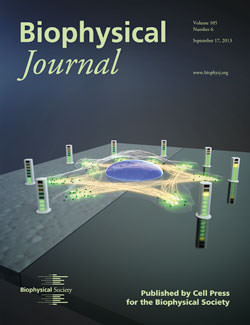
What does the world "look like" to a cell? Although they lack not only the sense organs that we humans rely on, but also any obvious downstream, hardwired machinery to process any such information, they are acutely and responsively aware of their surroundings. Not only in a chemical sense, sense of light, temperature, but also - as is becoming increasingly clear - mechanically. Somehow cells possess a touch-like sense, mechanosensitivity.
When I started my PhD project, I got instantly overwhelmed by the amount of different phenomena resulting from mechanosensing and the exuberant number of approaches that one can use to describe them. How from all this mish-mash of signaling pathways, elaborate models and reaction equations, one can figure out an orderly mechanism that would exploit realistic assumptions and rely solely on the external stiffness as an input signal? Science as cooking – so many ingredients you can use – but how to make a product that’s easy to digest, and yet has all of the nutrition that makes it useful for you? How to come up with an understandable theory without making it dull? How to choose from all the variety of the ingredients that you have in your pantry? Posing the right question is one of the ways to narrow down your search. Here we ask: what is the internally observable quantity that can represent the external rigidity? The answer is in our paper “Contractile fibers and catch bond clusters: a biological force sensor?”, where we did our best to cook up a simple yet flavorful model, incorporating all of the essential ingredients that will provide our cells with the ability to distinguish soft from hard.
As a cherry on the pie, comes the image that graces the cover of this issue. Luckily our university has a dedicated Animation Studio at the Institute for Complex Molecular Systems which gratefully helps researchers to beautifully visualize their results. We knew they'd help us come up with something good, as a while back an animation our group had made with their help won first prize in the Biophysical Society's "What is Biophysics" video contest. That winning video, and more links to beautiful science and imagery from our group, may be found here: http://www.youtube.com/user/icmstue.
In this case our image depicts a cell, which otherwise dark and featureless becomes actively bright where its integrins attach to the ECM, soft on one side, and stiff on the other. Having a double purpose, not only integrins are connecting the cell to the ECM, but they also convey the mechanical information about the rigidity of the substrate. Here the internal parameter- a fraction of bound integrins at each connecting point - can provide cell with access to spatially resolved mechanical information about its surroundings, which we hypothesize is a candidate first stage in mechanosensing. I like this image, because it provides a simple illustration for our model, which I hope, brought us a little closer to answering the question of how cells "see the world."
I enjoy reading the Biophysical Journal as it educates me on vast topics of modern research in my area of interest. This cover image accompanies my first publication as a grad student and I’ll definitely hang it on my wall as it is motivating and empowering!
- Written by Elizaveta Novikova